Where to See Japan’s Famous Autumn Colors: Tokyo and Beyond!
Japan’s autumn foliage, known as kōyō (紅葉) or momiji (when referring to maple leaves) transforms the country into a canvas of reds, oranges, and golds each fall. Much like the spring cherry blossoms, the turning leaves have been admired for centuries, inspiring poetry, art, and seasonal traditions, as well as drawing crowds for momijigari (紅葉狩り,“autumn-leaf viewing”) at gardens, temples, and mountains across Japan.
As temperatures drop, the colors gradually move from north to south, beginning in Hokkaido in late September and reaching the Tokyo and Kyoto regions by November/December. Knowing when and where to go can make all the difference; kōyō season is short, and timing it right lets you experience some of Japan’s most breathtaking scenery at its peak.
When to See Autumn Leaves in Japan
The timing of Japan’s autumn foliage season varies widely depending on the region and climate. Unlike cherry blossoms, which tend to bloom all at once and fade quickly, autumn colors sweep gradually from north to south, filling the country with the warmth and beauty of the season over nearly two months (typically from late September through early December). For 2025, forecasts show many areas are peaking slightly later than average due to warmer weather.
• Hokkaido (Northern Japan): late September – early October
Leaves begin changing in late September, with peak color in early October (the earliest in Japan). Mountainous areas like Daisetsuzan National Park often see vibrant colors by mid/late September, offering the first glimpse of autumn.
• Tokyo / Kanto region: mid-November – early December
For Tokyo and the broader Kanto region, the most vibrant period is commonly mid-November into early December. In 2025, the forecast for Tokyo predicts peak maple color around late November, with some urban sites possibly extending into early December, while nearby mountainous areas (e.g., Nikko or Hakone) can turn earlier in October.
• Kyoto / Kansai: mid-late November
In the Kansai region (including Kyoto and Osaka), the peak has traditionally been mid- to late November, with some gardens holding vivid colors into early December. In 2025, several spots are projected to reach their peak in early to mid-December, a delay compared with usual years.
• Kyushu & southern Japan: late November – December
The southern regions of Japan have a markedly later peak due to milder climates. For example, forecasts for Kyushu (e.g., Kagoshima) show peak colors around mid-December in 2025.
If you’re traveling across Japan, it’s worth checking the Japan Meteorological Corporation’s annual kōyō forecast, which tracks and predicts when and where the colors will appear each year. The forecast is regularly updated and helps travelers plan the best viewing times, especially as weather patterns shift slightly each season.
Tokyo’s Best Autumn Viewing Spots
You don’t have to leave the city to enjoy Japan’s famous autumn colors: Tokyo transforms into a sea of red and gold from late November to early December, with maples (momiji) and ginkgo trees brightening up parks, gardens, and even streets. Here are some of the best spots where you can see them.
1. Rikugien Garden (Bunkyō)
An Edo-period landscape garden inspired by classical poetry, Rikugien is home to paths circling a large pond framed by maple and ginkgo trees that glow red and gold from late November to mid-December. During peak season, evening illuminations reflect off the water, creating an almost dreamlike scene. The garden also extends its hours for this event, perfect for an evening stroll or photos.

2. Koishikawa Kōrakuen (Bunkyō)
Just a short walk from Tokyo Dome, this 17th-century garden offers one of Tokyo’s most breathtaking autumn sights. Its design recreates famous landscapes with ponds, bridges, and a small hill modeled after Chinese scenery. As you walk around the central pond, crimson maples frame the city skyline, a stunning contrast of nature and urban Tokyo.

3. Shinjuku Gyoen (Shinjuku)
A sprawling park that combines Japanese, English, and French-style gardens across 144 acres. This mix of landscapes gives Shinjuku Gyoen a long foliage season, with momiji and ginkgo trees coloring its lawns, ponds, and maple avenues. As a bonus, its Japanese, English, and French-style garden areas each offer a unique backdrop for the foliage.

4. Meiji Jingu Gaien (Shinjuku / Minato)
This large park in central Tokyo is home to Tokyo’s famous Ginkgo Avenue, a 300-meter path lined with hundreds of golden ginkgo trees, Meiji Jingu Gaien turns into a glowing tunnel of yellow from late November to early December. The area also hosts the lively Jingu Gaien Ginkgo Festival, where food stalls and music make the experience even more festive.
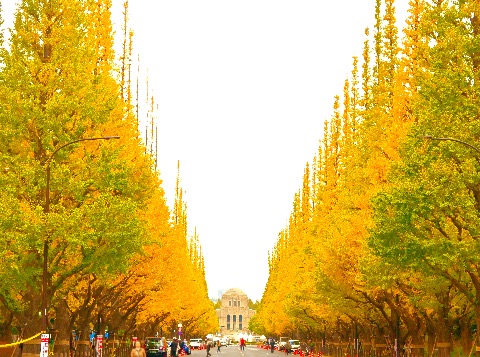
5. Showa Memorial Park (Tachikawa)
In western Tokyo, this vast national park is well-known for its seasonal beauty, especially its autumn colors. Two long ginkgo-lined boulevards (one near the park’s canal and one by a sports field) form golden corridors, their fallen leaves blanketing the ground. Meanwhile, the park’s traditional Japanese garden includes maples that turn fiery red, harmonizing with the garden’s ponds and teahouse for a more classic backdrop.

Day Trips from Tokyo for Autumn Colors
If you're looking to venture a bit outside the city, Tokyo’s outskirts and nearby prefectures are filled with scenic spots that make perfect autumn day trips.
1. Okutama (Tokyo’s West)
On Tokyo’s far western border, Okutama is a mountainous, forested escape that feels worlds away from the city. About 2 hours from central Tokyo, it’s home to scenic spots like Lake Okutama, Hatonosu Valley, and the upper Tama River valley; in autumn (late October to mid-November), the mountainsides explode in color. Hatonosu Valley is a particular highlight, where clear streams run past boulders and cliffs draped in red maples, a breathtaking sight against the turquoise river. You can also enjoy the view by driving the mountain roads or relaxing at local hot spring inns.
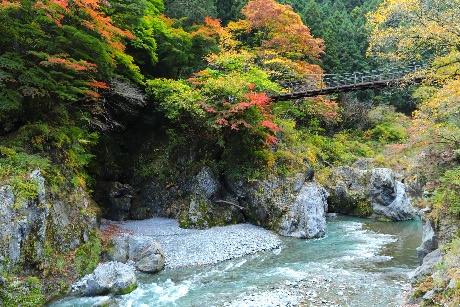
2. Lake Sagami (Kanagawa Prefecture)
Just beyond Tokyo in Kanagawa, Lake Sagami (Sagamiko) shines in autumn. Surrounded by low mountains, the lake’s foliage peaks from early to late November, a bit earlier than Tokyo’s. Forests around the lake and Mount Arashi (Arashiyama, not to be confused with Kyoto’s Arashiyama) turn brilliant shades of orange and red that reflect on the calm surface, doubling the beauty. The Lake Sagami Park area offers panoramic views framed by colorful trees, or you can rent a rowboat or pedal boat to see the colors up close. Only about an hour by train or car from Tokyo, it’s an easy day trip.

3. Nagatoro (Saitama Prefecture)
In the Chichibu region, about 90 minutes from Tokyo, Nagatoro is famous for its river gorge and vivid autumn scenery. The Arakawa River winds through the Iwadatami Rocks, and by November, the valley bursts into red, orange, and gold. One of the best ways to enjoy it is on a traditional wooden boat ride: some calm and relaxing, others a little more thrilling with rapids if you’re up for adventure. Nagatoro also hosts an Autumn Leaves Festival at Tsuki no Ishi Momiji Park, where maple trees are illuminated nightly from November 7–30.

4. Mount Mitake (Tokyo/Ome)
Within Chichibu-Tama-Kai National Park, Mount Mitake (929 m) offers one of Tokyo’s best mountain foliage spots, about 95 minutes from Shinjuku. The summit (reachable by cable car) and shrine area see colors earlier than the city, with golden ginkgo and crimson maple leaves peaking in early November. Trails around Musashi-Mitake Shrine and the Rock Garden path feature mossy streams and small waterfalls, making for a scenic hike. During the Tenku Momiji Festival (late October–November), the foliage is illuminated at night, and performances bring the mountain to life. At the base, Mitake Gorge offers a peaceful riverside walk along the Tama River, where bright leaves reflect beautifully on the clear water.
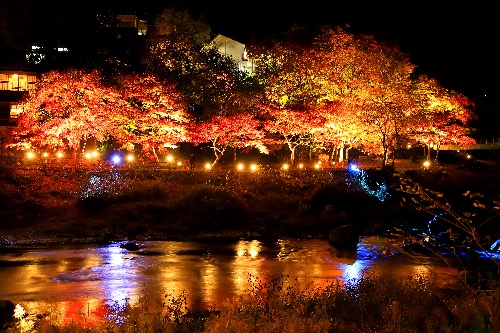
Further Afield: Famous Autumn Leaves Spots Across Japan
Beyond the Tokyo region, nearly every corner of Japan has its own beloved kōyō spots. If your travels take you farther, these destinations offer some of the country’s most unforgettable autumn views.
Kyoto (Kyoto Prefecture)
Often called the crown jewel of Japan’s autumn season, Kyoto is unmatched for its concentration of historic temples and gardens framed by maples. In late November, the scenery is at its most spectacular: in Arashiyama, the iconic Togetsukyo Bridge overlooks forested hillsides glowing red and gold, while Kiyomizu-dera Temple offers sweeping views from its wooden veranda across a valley of blazing foliage. Other highlights include Eikan-dō, famous for its illuminated reflection pond, and Tōfuku-ji, where a pathway of maples creates a crimson carpet viewed from a wooden bridge. Kyoto’s colors typically peak from mid to late November, with many temples extending hours for special evening light-ups.
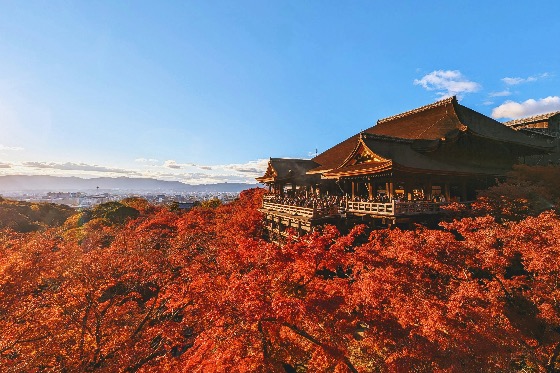
Nikkō (Tochigi Prefecture)
Nikkō’s mountainous forests are legendary for their autumn views. Around Lake Chūzenji and Kegon Falls, you’ll find brilliant displays of red, yellow, and orange reflected in the water. The drive up the Irohazaka Winding Road is especially scenic: as you climb, the leaves shift color with the altitude. Lower areas like Ryuzu Falls and Toshogu Shrine reach their peak in early November, offering a perfect mix of nature and heritage. For more hiking and quiet viewpoints, nearby Kirifuri Highlands and Nasu Kogen are also worth a visit.
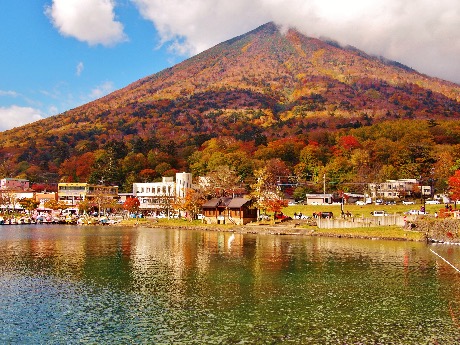
Miyajima (Hiroshima Prefecture)
The sacred island of Miyajima is famous not only for its floating torii gate but also for Momijidani Park (“Maple Valley Park”), where hundreds of Japanese maples turn brilliant red in mid to late November. Walking along its small bridges and streams under a canopy of crimson leaves feels magical, especially during the evening light-ups. For panoramic views, take the ropeway up Mount Misen, where the autumn colors meet the blue of the Seto Inland Sea.
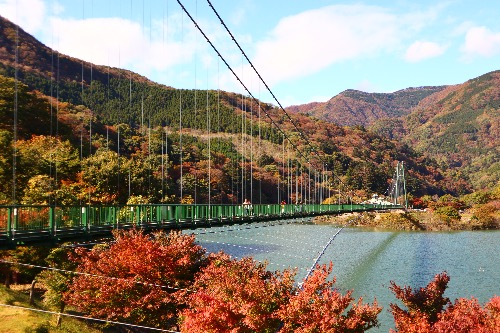
Fuji Five Lakes (Yamanashi Prefecture)
The area surrounding Mount Fuji offers postcard-perfect autumn scenery. Lake Kawaguchi is especially popular for its Momiji Corridor, a tunnel of maple trees framing Fuji in the background. The colors peak in early to mid-November, when the Fuji Kawaguchiko Autumn Leaves Festival fills the lakeside with food stalls, crafts, and night illuminations.
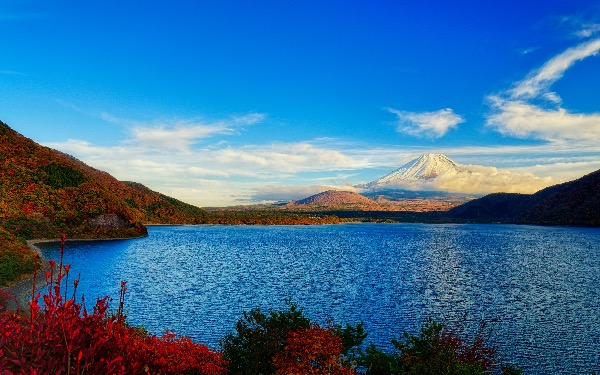
Finding Autumn’s Magic Across Japan
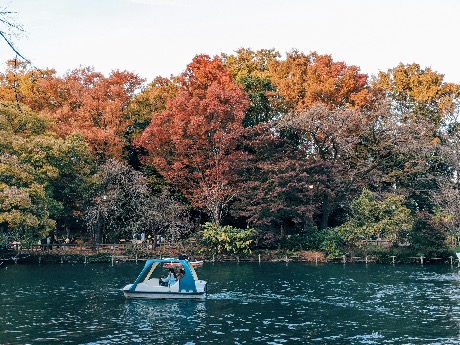
Autumn in Japan may be short-lived, but it’s one of the country’s most magical times. Since the timing of momiji season changes every year depending on the weather, it’s always worth checking live foliage forecasts (like Japan-Guide’s Autumn Color Report) before planning your trip. If you’re visiting famous destinations such as Kyoto, Nikkō, or the Fuji Five Lakes, booking accommodations early helps you secure better rates and stay close to top viewing spots. And visiting early in the morning or on weekdays also lets you enjoy the vibrant scenery without the crowds, so you can take your time to really appreciate the view.
Beyond the colors themselves, Japan’s autumn is an experience worth savoring: as gardens and temples host seasonal festivals and light-up events (ライトアップ), the crisp air and glowing trees create the perfect setting to enjoy roasted sweet potatoes, chestnuts, or even maple-leaf tempura. Just remember to respect local etiquette: stay on paths, don’t touch the leaves, and be mindful when taking photos so everyone can enjoy the moment. With a little planning, and an extra layer or two, you’ll be ready to experience Japan’s fall season at its most beautiful!
🍁 Experience Japan in Every Shade
If you’d love to explore some of these breathtaking autumn spots in person, an internship in Japan can be the perfect way! Not only will you get to see these stunning views up close, but you’ll also gain professional experience, meet new people, and discover Japan’s culture beyond travel. Join the program or reach out to us to start your journey!







